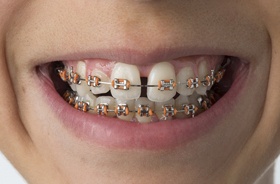
Very rarely, serious conditions can be the cause of gaps in your teeth. Kaplan Orthodontics are proud to offer a complimentary consultation to help you with this process. Only your orthodontist can determine if your gaps will require treatment, and if so, what kind of treatment. If it’s done in an older child or an adult, the space may still need to be closed with braces. If a frenectomy is done in a younger child, the space may close on its own over time. If a large labial frenum is causing the gap, the frenum can be reduced through surgery called a frenectomy. This may include dental implants, a bridge, or even a partial denture. If you have a space because you’re missing teeth, you might also need more extensive repair work done, such as tooth implants or a bridge. That’s because moving any teeth affects your entire mouth.
Gapped teeth braces full#
Often, no matter where the gap originates, you must wear a full set of braces on both your upper and lower teeth. When a patient seeks orthodontic treatment for a tooth gap, some will choose to get braces, which move the teeth together. Also, some patients may feel that treatment is necessary to improve their appearance, even if no other health problems are present. Smaller gaps that aren’t otherwise an issue can be nothing more than a mild annoyance (or even add a dash of whimsy when to comes to your smile!) But gaps in adults that are too big, or ones that are bordered by unhealthy teeth, can cause new problems or exacerbate existing ones. However, not all gaps are a cause for concern. This can lead to bite problems, facial discomfort and pain, and other dental issues. Gaps can occur at any point in your life, leading to the possibility of poor tooth alignment since the teeth bordering the gap have nothing to control movement. There’s more to a gap-toothed smile than aesthetics, though!


In other cases, the gap itself is the only problem. Sometimes, a gap in your teeth may be part of a set of problems that require orthodontic treatment to correct. To treat or not to treat, that is the question It’s worth noting that children often have temporary gaps as their baby teeth fall out, but most of these spaces will close as the permanent teeth reach their final positions. The teeth may then become loose, as mentioned above, and discomfort or pain could occur, particularly during biting or chewing. Tooth gaps don’t generally present “symptoms,” as such, but spaces caused by habits like thumb-sucking or extended bottle use, or more serious issues like periodontal disease, will tend to expand or grow with time. If it’s oversized, it can keep the teeth from coming together properly by growing down in between them.

It’s possible to address and correct this problem, but is it always necessary? Here at Kaplan Orthodontics, we believe in keeping our patients informed of all the ins and outs of any potential treatment plan, and that includes an honest look at all the services we provide. Gap teeth are one of the most common cosmetic dental issues, and can be caused by everything from thumb-sucking to gum disease.


 0 kommentar(er)
0 kommentar(er)
